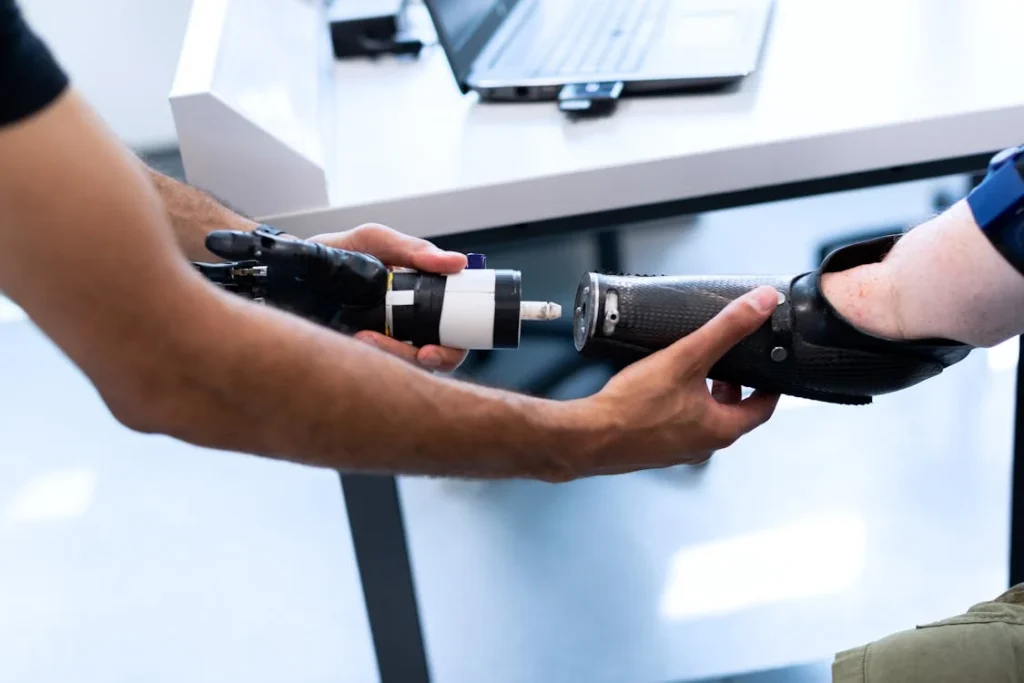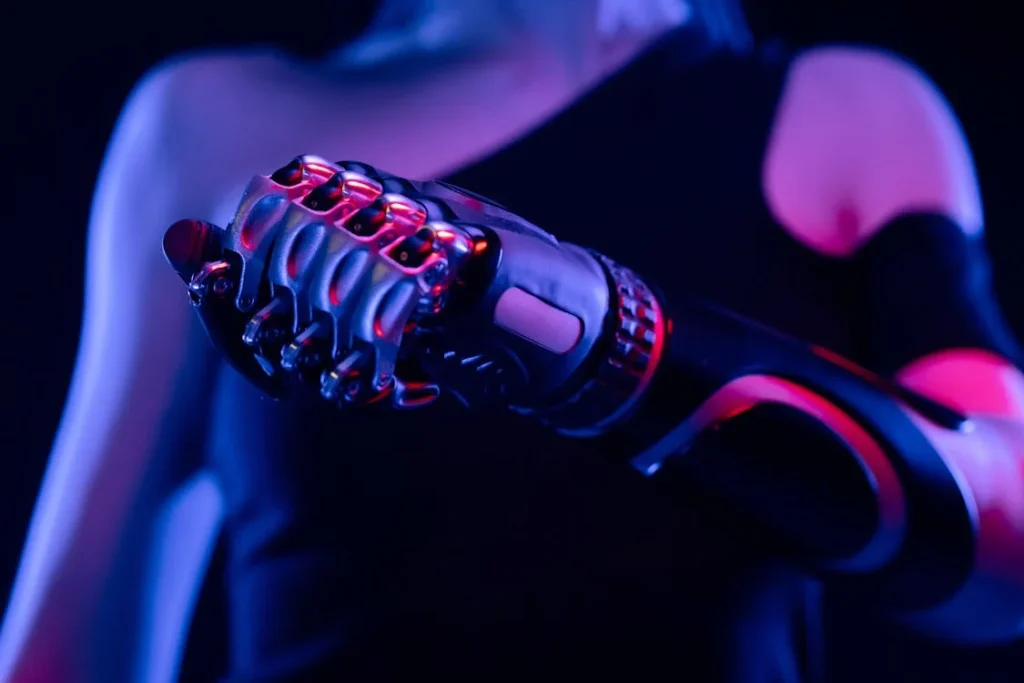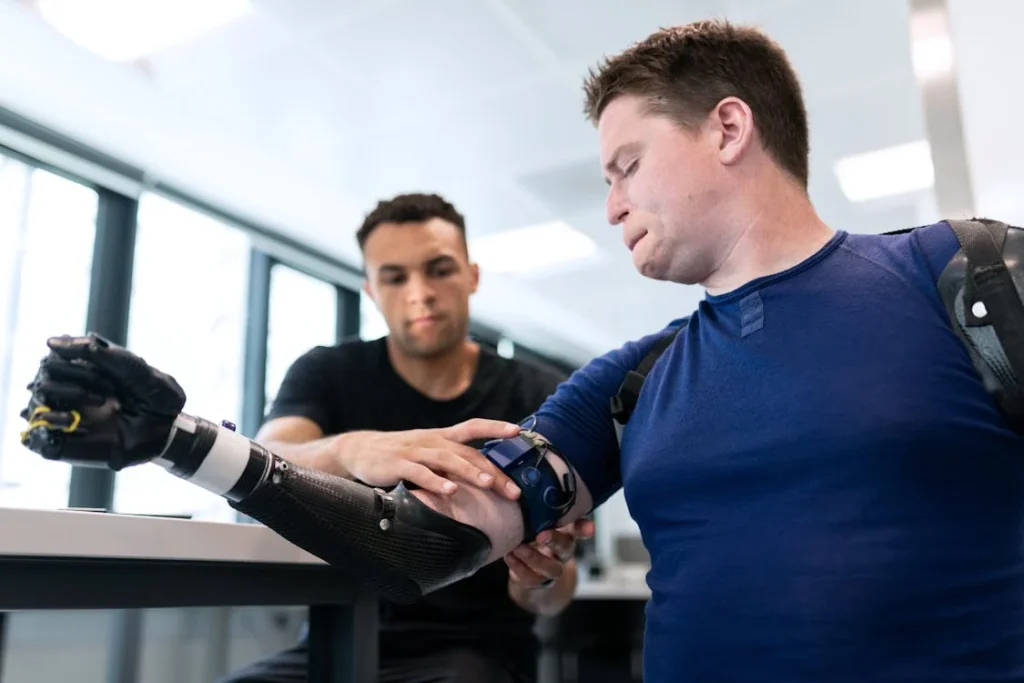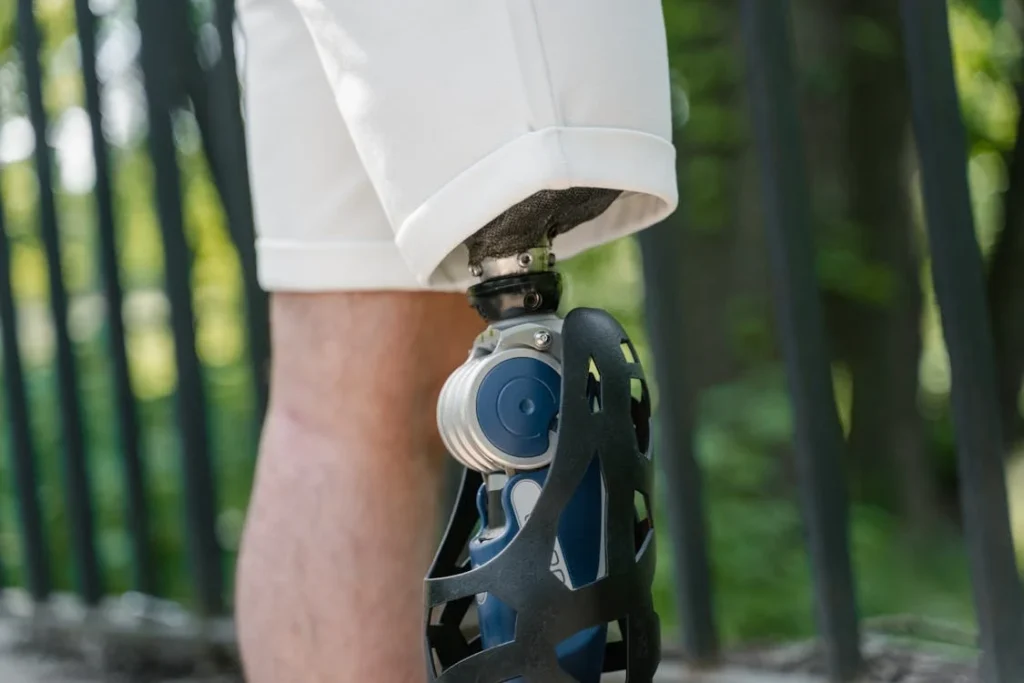Prosthetic training is a crucial part of your journey toward regaining independence and mobility after an amputation. It is a structured process that helps you adapt to your prosthetic limb, teaching you how to use it effectively in your daily life. While the idea of starting prosthetic training might feel overwhelming at first, with the right preparation and mindset, it can be an empowering and transformative experience.
This guide takes you through the essential steps to prepare for prosthetic training, ensuring you are equipped physically, emotionally, and mentally to make the most of this journey.

Building the Foundation for Success
The journey to successful prosthetic training begins long before you step into your first session. Laying a strong foundation ensures you are prepared physically, emotionally, and mentally for the challenges and achievements that lie ahead.
Each step in this preparatory phase is an investment in your recovery and future mobility, setting the stage for a smoother and more effective training experience.
Understanding the Purpose of Prosthetic Training
Before starting prosthetic training, it is important to understand why this process is so vital. A prosthetic limb is more than a tool—it becomes an extension of your body, helping you restore movement, functionality, and independence.
However, using a prosthetic requires practice, coordination, and physical adaptation. Training focuses on teaching you how to perform tasks, improve balance, and move confidently with your prosthetic.
Your prosthetic training will be personalized to meet your specific needs. Whether you have an upper-limb or lower-limb prosthetic, the goal is to help you integrate it seamlessly into your daily life.
With the guidance of skilled professionals, you’ll develop the skills necessary to overcome challenges and build confidence in your abilities.
Setting Clear and Achievable Goals
A key element of building the foundation for success is setting clear and realistic goals for your rehabilitation journey. These goals serve as both a roadmap and a source of motivation, guiding your efforts and helping you track your progress.
Whether you aim to walk unaided, return to work, or perform daily activities with greater ease, having a clear vision of what you want to achieve can keep you focused and inspired.
Goal setting should be a collaborative process between you and your rehabilitation team. They will help you break down larger aspirations into smaller, manageable milestones, ensuring each step is both achievable and meaningful.
These milestones create a sense of accomplishment, reinforcing your confidence and encouraging you to keep pushing forward.
Understanding Your Body’s Needs
Every individual’s journey is unique, and preparing for prosthetic training involves understanding the specific needs of your body.
Factors such as the level and type of amputation, the condition of your residual limb, and your overall health all influence how you approach rehabilitation. Taking the time to assess these factors ensures that your training plan is tailored to your unique circumstances.
This process often begins with consultations and evaluations conducted by your healthcare team. These assessments provide valuable insights into your physical strengths and areas for improvement, helping to create a customized plan that maximizes your potential.
By understanding your body’s needs, you can focus your efforts where they will have the greatest impact.
Creating a Supportive Environment
A supportive environment is essential for building the foundation for success. This includes not only your physical surroundings but also the people and resources that surround you.
Your home should be adapted to make daily activities easier, with adjustments that enhance accessibility and reduce the risk of accidents. Simple changes, such as clearing walkways or installing handrails, can make a significant difference as you begin prosthetic training.
Equally important is the emotional support you receive from family, friends, and your rehabilitation team. Having a network of people who understand your journey and are invested in your success creates a sense of encouragement and belonging.
These connections remind you that you are not alone and that others are there to help you navigate the challenges of recovery.
Embracing a Learning Mindset
Preparing for prosthetic training also involves adopting a mindset of curiosity and openness. Using a prosthetic limb is a new skill that requires patience, practice, and a willingness to learn.
Approaching this process with a positive attitude allows you to see challenges as opportunities for growth rather than obstacles.
Your rehabilitation team will introduce you to new techniques, exercises, and tools that may initially feel unfamiliar or even difficult. Embracing these learning experiences with a sense of determination helps you adapt more quickly and effectively.
It’s important to remember that progress is often incremental and that each small step forward brings you closer to your goals.
Building Trust in the Process
Trust is a vital part of building the foundation for success. Trusting your healthcare team, the prosthetic device, and your own abilities creates a sense of stability and confidence as you begin training.
This trust is built through open communication, consistent effort, and a commitment to the process.
Working closely with your prosthetist and therapist ensures that your concerns and questions are addressed. Their expertise and guidance provide reassurance, helping you feel supported at every stage of your journey.
Similarly, trusting yourself—believing in your resilience and ability to overcome challenges—reinforces your determination to succeed.
By focusing on these foundational elements, you create a strong base for prosthetic training that supports both your physical and emotional recovery.
This preparation not only makes the training process smoother but also empowers you to approach each step with confidence and purpose.

Building Physical Readiness
Preparing your body for prosthetic training is a crucial part of the rehabilitation process. Physical readiness lays the groundwork for success, ensuring that your body has the strength, flexibility, and endurance needed to adapt to a prosthetic limb.
This preparation is not limited to a specific area of the body; it involves a holistic approach that strengthens key muscle groups, enhances balance, and supports overall mobility.
Strengthening Your Core and Supporting Muscles
Physical preparation goes beyond the residual limb—it involves strengthening your entire body. Your core muscles, located in the abdomen, lower back, and pelvis, play a key role in maintaining balance and stability while using a prosthetic.
Exercises that target these muscles help you move with greater confidence and reduce the risk of falls.
Supporting muscles in the arms, shoulders, and remaining leg (for lower-limb amputees) are equally important. These muscles often take on additional responsibilities to compensate for the missing limb. Strengthening them ensures they can handle these demands without strain.
Your physical therapist will design a personalized exercise plan that gradually increases in intensity as you build strength. This plan might include activities like leg presses, weight shifting, or resistance exercises, depending on your specific needs.
Regular practice improves not only physical strength but also coordination and endurance, which are essential for successful prosthetic use.
Enhancing Flexibility and Range of Motion
Flexibility is another key component of physical readiness. Tight or stiff muscles can limit your range of motion, making it harder to perform movements smoothly and effectively.
Stretching exercises are essential for maintaining flexibility, particularly in the joints and muscles surrounding your residual limb. These stretches not only improve mobility but also help reduce discomfort and prevent injury during prosthetic training.
For lower-limb amputees, maintaining flexibility in the hips, knees, and ankles is crucial for walking and standing.
Upper-limb amputees benefit from exercises that improve the range of motion in the shoulders, elbows, and wrists, enabling them to perform tasks with ease. Regular stretching sessions help you stay agile and adaptable, allowing your body to move freely and efficiently.
Strengthening Supporting Muscles
In addition to core muscles, the supporting muscles around your residual limb and in your remaining limbs play a vital role in physical readiness.
These muscles often take on additional responsibilities, such as bearing extra weight or compensating for lost movement. Strengthening these areas ensures that they can handle these demands without strain or fatigue.
Physical therapy focuses on targeted exercises that build strength and endurance in these muscles. For lower-limb amputees, activities that strengthen the remaining leg are particularly important, as this limb provides much of the support needed for standing and walking.
For upper-limb amputees, the opposite arm and shoulder muscles are trained to manage increased workloads, such as lifting or gripping.
Strengthening these muscles also improves overall coordination, allowing your body to work more effectively as a whole.
This balance between strength and coordination creates a solid foundation for advanced movements, such as walking with a prosthetic or performing daily tasks.
Improving Endurance for Daily Activities
Endurance is a crucial aspect of physical readiness, as prosthetic use requires sustained energy and stamina. Building endurance involves gradually increasing your ability to perform activities over extended periods without becoming overly fatigued.
This preparation is particularly important for individuals who plan to return to work, hobbies, or other physically demanding activities.
Therapists often incorporate exercises that mimic real-world scenarios, such as walking for longer distances or practicing repetitive movements.
These activities help your body adapt to the physical demands of using a prosthetic, ensuring you can engage fully in your daily life without discomfort or exhaustion.
Preparing the Residual Limb
One of the first steps in preparing for prosthetic training is ensuring your residual limb is ready. This involves managing swelling, shaping the limb for a proper fit, and addressing any skin sensitivities.
Your healthcare team will guide you through this process, which often includes wearing compression garments or sleeves to reduce swelling and help the limb heal properly.
Caring for your residual limb is an ongoing process that requires attention and consistency. Regularly cleaning and moisturizing the skin helps prevent irritation and keeps it healthy.
It’s also important to monitor for any signs of discomfort, pressure sores, or redness, as these could affect how your prosthetic fits.
Stretching and strengthening exercises for the muscles around the residual limb are equally important. These activities improve flexibility and prepare the limb for weight-bearing activities.
By focusing on the health and strength of your residual limb, you set the stage for successful prosthetic training.

Developing Emotional and Mental Preparedness
The journey of prosthetic training is as much a mental and emotional experience as it is a physical one. Preparing your mind and emotions for the challenges ahead is a crucial step in ensuring a successful rehabilitation process.
This phase involves cultivating resilience, building confidence, and learning how to approach the journey with patience and determination. By addressing these aspects early on, you equip yourself with the tools needed to navigate the ups and downs of recovery.
Building Confidence Through Knowledge
Starting prosthetic training can bring up feelings of uncertainty or fear, especially if you’re unsure about what to expect. Building confidence begins with knowledge.
Understanding the training process, setting realistic goals, and learning about your prosthetic limb’s capabilities can help ease these concerns.
Your rehabilitation team will guide you through every step, from initial fittings to advanced tasks. Knowing that you have a supportive and experienced team by your side can provide reassurance and motivation.
Taking the time to ask questions and address your concerns also helps you feel more in control of your journey.
Cultivating Patience and Positivity
Adapting to a prosthetic limb is a gradual process that requires patience. It’s natural to feel frustrated or discouraged at times, but maintaining a positive outlook can make a significant difference.
Focusing on small achievements, such as standing or walking a few steps, reinforces your progress and reminds you of your capabilities.
Visualization techniques can also help you prepare mentally for prosthetic training. Imagining yourself successfully using the prosthetic limb, performing tasks, or moving confidently creates a sense of optimism and readiness.
These mental exercises complement your physical efforts, creating a holistic approach to preparation.

Familiarizing Yourself with Your Prosthetic
Understanding your prosthetic limb is a critical step in the journey toward independence and functionality.
While the device may initially feel unfamiliar, taking the time to become acquainted with its features and capabilities transforms it into a valuable tool that supports your daily life.
Familiarization is not just about learning how to use the prosthetic but also about developing a sense of trust and comfort with it.
Learning About Your Prosthetic
Understanding the design, function, and components of your prosthetic limb is a critical part of preparation. Each prosthetic is tailored to your specific needs, incorporating features that support your lifestyle and goals.
For example, a lower-limb prosthetic may include a foot designed for walking on uneven surfaces, while an upper-limb prosthetic might have grips optimized for fine motor tasks like holding a pen or picking up objects.
Your prosthetist will walk you through the details of your device, explaining how it works and what to expect during training. This knowledge not only helps you feel more comfortable with the prosthetic but also allows you to take full advantage of its capabilities.
Initial Fittings and Adjustments
The initial fitting of your prosthetic is an essential step in ensuring its comfort and functionality. During this process, your prosthetist will assess how the prosthetic fits on your residual limb, making adjustments to improve alignment and reduce pressure points.
A well-fitted prosthetic not only enhances comfort but also ensures stability and reduces the risk of injury.
This phase may require several visits as your limb continues to heal and change shape. Staying patient and communicating openly with your prosthetist about any discomfort or concerns is important.
These adjustments lay the groundwork for a successful training experience, ensuring that your prosthetic feels like a natural extension of your body.

Starting the Prosthetic Training Process
Beginning prosthetic training is an important milestone on your journey toward mobility and independence. It is a time of discovery, adjustment, and growth as you learn to use your prosthetic limb effectively.
The process starts with simple movements and gradually progresses to more complex tasks, ensuring you build confidence and competence at a steady pace. Each session is designed to address your specific needs, helping you adapt both physically and mentally.
Laying the Groundwork
The first step in prosthetic training focuses on building a strong foundation. Before you can master advanced movements, you need to become comfortable with the basics. For lower-limb prosthetic users, this often means learning to stand and balance with the device.
Balancing requires understanding how your weight shifts and how the prosthetic responds to your body’s movements. These initial exercises help you gain awareness of your center of gravity, which is essential for walking and other activities.
For upper-limb prosthetic users, training begins with fundamental tasks such as opening and closing the hand or lifting lightweight objects.
These exercises allow you to understand the prosthetic’s range of motion and how to control it effectively. Early sessions emphasize precision and coordination, laying the groundwork for more intricate movements in the future.
Developing Trust in the Prosthetic
As you start using your prosthetic, one of the most important aspects of training is developing trust in the device. Initially, it may feel unfamiliar or even awkward, but with consistent practice, you begin to understand how it works and how it complements your movements.
This trust is built through repetition and guided support from your rehabilitation team.
Your therapist will provide reassurance and adjustments as needed, helping you feel secure and confident. They will guide you through exercises that gradually increase in complexity, allowing you to experience the prosthetic’s capabilities in a controlled environment.
With each successful attempt, your confidence in the prosthetic grows, making it easier to tackle new challenges.
Refining Movements
The training process also focuses on refining your movements to ensure they are smooth, efficient, and natural. For lower-limb prosthetic users, this involves learning a proper gait pattern.
Walking with a prosthetic requires coordinating the movement of your residual limb, the prosthetic, and the rest of your body. Therapists often use tools like parallel bars or mirrors to help you observe and adjust your posture and alignment.
For upper-limb users, refinement includes improving the accuracy of gripping, lifting, and releasing objects. These movements may feel slow or deliberate at first, but as you practice, they become more fluid and intuitive.
Each session builds on the progress of the previous one, creating a sense of momentum and achievement.
Balancing and Weight Distribution
One of the first skills you’ll learn during prosthetic training is how to balance and distribute your weight effectively. This step is crucial for building confidence in standing and walking with your prosthetic.
Your physical therapist will guide you through exercises that focus on stabilizing your body, helping you find your center of gravity.
For lower-limb prosthetic users, weight-shifting exercises are a common starting point. These movements teach you to transition your weight from one side to the other, a fundamental skill for walking.
Upper-limb prosthetic users may begin with tasks that involve grasping and releasing objects, which help improve coordination and build familiarity with the prosthetic’s movements.
As you gain confidence in these foundational skills, you’ll progress to more advanced activities, such as walking on uneven surfaces or performing daily tasks.
Adapting to New Challenges
As you gain proficiency in basic movements, the training process introduces new challenges to prepare you for real-world scenarios. These challenges might include navigating uneven surfaces, climbing stairs, or carrying objects while walking for lower-limb users.
Upper-limb users may practice handling delicate items, using tools, or performing tasks that require fine motor skills.
These scenarios simulate the demands of daily life, helping you feel prepared and capable when faced with similar situations outside of therapy.
Adapting to these challenges also reinforces your problem-solving skills, allowing you to find creative solutions and build confidence in your ability to navigate the world independently.
The Role of Feedback
Throughout the prosthetic training process, feedback plays a critical role. Your therapist observes your movements closely, providing constructive input on how to improve your technique.
This feedback helps you identify areas where adjustments are needed, whether it’s shifting your weight more evenly, refining your grip, or maintaining better posture.
Your own observations are equally important. Noticing how the prosthetic feels during different activities—whether it’s comfortable, secure, or slightly off—allows you to communicate your experiences to your prosthetist.
These insights lead to adjustments that enhance the fit and functionality of the device, ensuring it meets your needs as you progress.
Building Resilience and Motivation
Starting prosthetic training is a significant step forward, but it can also be challenging at times. There may be moments when progress feels slow or certain movements seem difficult to master.
Building resilience is essential during these times. Reminding yourself of your goals and reflecting on how far you’ve come can provide the motivation needed to keep going.
Each session is an opportunity to learn, grow, and gain a deeper understanding of your prosthetic and your body. As you progress through the training process, you’ll begin to see the possibilities that lie ahead, reinforcing your determination to succeed.

Overcoming Challenges and Building Confidence
The process of adapting to a prosthetic limb is not without its hurdles. Each individual’s journey comes with unique challenges that test physical, emotional, and mental resilience.
These challenges, however, are also opportunities to grow stronger and more capable. Overcoming them is a gradual process that builds the confidence necessary to embrace life with renewed independence and purpose.
Addressing Frustrations
It’s normal to encounter challenges during prosthetic training, from adjusting to the fit of the device to mastering new movements. These frustrations are a natural part of the learning process, and it’s important to approach them with patience and self-compassion.
Every challenge you face is an opportunity to grow stronger and more adept at using your prosthetic.
Communicating openly with your rehabilitation team about any difficulties ensures that you receive the guidance and support you need. Whether it’s modifying an exercise, addressing discomfort, or simply providing encouragement, your team is there to help you succeed.
Celebrating Small Victories
Success in prosthetic training is built on small victories. Each new skill you master, whether it’s standing without assistance or completing a specific task, represents a step forward in your recovery.
Celebrating these achievements reinforces your progress and motivates you to keep pushing toward your goals.
Acknowledging these milestones also helps you stay focused on the bigger picture. By recognizing how far you’ve come, you build confidence in your ability to overcome challenges and embrace the possibilities ahead.
Conclusion
Prosthetic training is a transformative journey that empowers individuals to reclaim independence and embrace new possibilities. It is not just about mastering movements but about building confidence, resilience, and a sense of control over life’s challenges. Each step forward, from preparing the residual limb to achieving advanced skills, is a testament to the strength and determination within you.
At Robobionics, we understand that this process is deeply personal, and we are committed to providing the support, expertise, and advanced prosthetic solutions you need to succeed. Your journey is unique, and so is your potential to overcome obstacles and achieve your goals. By focusing on consistent effort and maintaining a positive mindset, you can turn the challenges of rehabilitation into opportunities for growth. Contact us today to begin your path toward a future filled with mobility, independence, and confidence.



